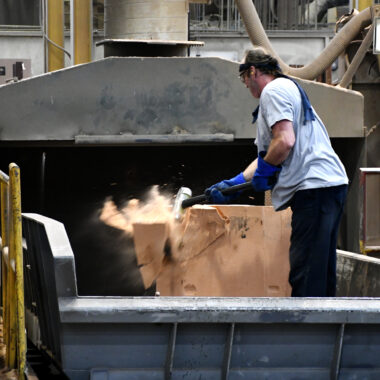Introducing the Different Sorts Of Aluminum Spreading Processes for Accuracy Outcomes
Aluminum casting processes play an essential function in the manufacturing sector, providing a broad array of methods to attain accuracy cause the manufacturing of detailed parts and parts. From die casting to sand spreading, financial investment spreading, permanent mold spreading, and centrifugal casting, each approach brings its own collection of benefits and details to the table. Recognizing the subtleties of these procedures is necessary for makers looking for to maximize their production processes and make sure the finest end results. By exploring the distinctive features of each casting technique, a deeper insight into the globe of aluminum spreading can be gained, clarifying the ideal technique for accomplishing accuracy outcomes in numerous applications.
Pass Away Casting Refine
The Die Casting Refine is a very efficient manufacturing approach for generating geometrically complicated steel parts with high accuracy and repeatability. This process involves compeling liquified metal right into a steel mold dental caries under high pressure. The mold and mildew, likewise called a die, is typically made in two components: the cover pass away half and the ejector die half. These passes away are developed to produce the wanted form of the last item.
Among the crucial benefits of die casting is its ability to produce parts with thin wall surfaces, complex details, and smooth surfaces. This makes it a favored selection for sectors such as vehicle, aerospace, and electronic devices where complex steel parts are required. Furthermore, die casting deals exceptional dimensional accuracy, enabling minimal post-processing requirements.
Additionally, die casting can be classified into warm chamber and cold chamber pass away casting processes. In warm chamber pass away casting, the molten steel is contained in a heater while in cool chamber pass away spreading, the molten metal is ladled right into the cool chamber for each shot. aluminum casting. Each method has its own collection of advantages and is picked based on the specific demands of the task
Sand Spreading Technique
Utilizing a centuries-old technique, the sand spreading approach is a widely made use of procedure in the production market for developing steel components. This method includes creating a mold constructed from compacted sand into which liquified metal is poured, permitting it to solidify and take the shape of the mold tooth cavity. Sand spreading is valued for its convenience, as it can create a large range of complicated sizes and shapes, making it suitable for various markets such as auto, aerospace, and art foundries.
Despite its long background, modern-day innovations in sand spreading methods, such as the use of computer system simulations for mold and mildew style and 3D printing for producing intricate patterns, have better enhanced the accuracy and effectiveness of the procedure. On the whole, the sand spreading technique remains a popular selection for suppliers looking for a trusted and affordable means to create premium metal parts.
Financial Investment Casting Method

This method is favored for its capacity to create complex forms with high precision and fine surface finishes. Industries such as aerospace, auto, and fashion jewelry rely upon financial investment spreading for components that call for complex details and limited tolerances. The process permits affordable manufacturing of little to medium-sized components in different products, making it a flexible selection for makers seeking accuracy results.
Long-term Mold Casting
With a concentrate on developing metal parts with a multiple-use mold, Irreversible Mold Casting supplies an alternative strategy to the elaborate accuracy of financial investment casting. aluminum casting. This approach, also referred to as gravity pass away spreading, involves using an irreversible metallic mold and mildew commonly made from steel or cast iron. The mold and mildew is pre-heated before the molten steel is put into it, enabling faster solidification compared to sand casting
Irreversible Mold Casting allows the manufacturing of high-quality, dimensionally precise components with a fine surface finish. By utilizing a multiple-use mold, manufacturers can accomplish price savings in time as the mold can be utilized numerous times without substantial wear and tear. This process is perfect for high-volume manufacturing runs where uniformity and efficiency are essential.
One of the crucial benefits of Irreversible Mold Casting is its capability to create complicated shapes and complex styles with convenience. aluminum casting. The method is commonly used in the vehicle, aerospace, and electronic devices markets for producing elements such as engine parts, warm sinks, and structural aspects

Centrifugal Casting Technique
The Centrifugal Casting Technique is a method that entails revolving a mold at broadband while putting molten steel into it. This process makes use of centrifugal force to visite site disperse the liquified metal equally along the walls of the mold and mildew, resulting in a premium, thick casting. The centrifugal force presses impurities and gases towards the internal diameter of the spreading, resulting in a cleaner end product with improved mechanical residential or commercial properties.
One of the vital advantages of centrifugal casting is the capacity to produce disk-shaped or cylindrical components with a fine-grained framework that enhances the mechanical residential properties of the casting. This approach is particularly suitable for producing in proportion components such as rings, pipelines, and tubes. In addition, centrifugal spreading offers the advantage of being a cost-efficient procedure with relatively low tooling expenses compared to various other casting techniques.
Verdict
To conclude, understanding the numerous types of aluminum casting processes is important more helpful hints for accomplishing exact cause production. Each technique has its own benefits and limitations, making it important to select the most suitable process based upon the certain demands of the job. Whether it is die casting, sand casting, financial investment spreading, permanent mold casting, or centrifugal casting, picking the appropriate strategy can bring about cost-efficient and high-grade manufacturing results.
From die spreading to sand casting, investment spreading, long-term mold casting, and centrifugal casting, each approach brings its very own set of benefits and details to the table. By discovering the distinctive attributes of each casting approach, a deeper insight right into the globe of light weight aluminum spreading can be gained, losing light on the optimum approach for attaining accuracy results in various applications.
In warm chamber pass away casting, the molten metal is contained in a heating system while in chilly chamber pass away advice casting, the molten steel is ladled right into the cool chamber for each shot.With a focus on developing steel components through a multiple-use mold and mildew, Long-term Mold Casting provides an alternate method to the detailed precision of investment casting. Whether it is pass away spreading, sand spreading, investment spreading, permanent mold casting, or centrifugal spreading, choosing the ideal strategy can lead to premium and cost-effective production end results.